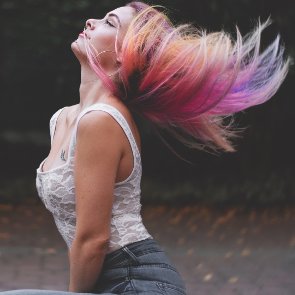5 Things That Can Make Your Hair Color Fade
 Even persistent hair dyes start to fade eventually, more and more with every wash. The speed of fading depends on many factors such as the structure of your hair and the type of dye you use (for example, vibrant hair colors like green or pink fade faster than natural shades). In fact, there are a lot of things that can make your hair color fade faster.
Even persistent hair dyes start to fade eventually, more and more with every wash. The speed of fading depends on many factors such as the structure of your hair and the type of dye you use (for example, vibrant hair colors like green or pink fade faster than natural shades). In fact, there are a lot of things that can make your hair color fade faster.Hard and Chlorinated Water
Hard water is water with high mineral content. The hardness of water in your tap depends on its source, but the majority of households in developed countries are believed to have hard water. Calcium and magnesium ions contained in hard water tend to build up on the hair over time and can block pigment from penetrating the hair shaft. This results in a less saturated color and quicker fading.
In some places, tap water is chlorinated to kill certain bacteria and microbes. Pool water is usually chlorinated too. Just like calcium and magnesium, chlorine can strip hair color. Although there isn’t much you can do about tap water, you need to protect your hair from chlorinated water in the pool. Always soak it with fresh water before entering the pool, then apply some coconut or argan oil to your wet hair, and don’t forget to use a deep conditioning mask or at least a hydrating conditioner when you wash your hair after swimming.
High Temperatures and UV Radiation
If you rinse your hair with too hot water, blow dry it regularly, or heat style too often, be prepared to see its color fade extremely quickly because heat causes the cuticle to open and destroys the molecules of pigment. To make your hair color last longer, rinse with lukewarm water, use your blow dryer and heat styling tools only when it’s absolutely necessary, and don’t forget about heat protection products. If you dye your hair constantly, think about investing in professional-quality styling tools that only reach a safe temperature for color-treated hair.
UV rays also cause hair color to fade, so you need to protect your hair from the sun. There are a lot of leave-in products that provide UVA/UVB protection and seal the cuticle to keep color intact. If you don’t have one, at least wear a hat whenever you go outside in sunny weather.
Ingredients in Your Hair Care Products
Commercial shampoos, conditioners and hair styling products can contain sulfates (for example, SLS/SLES – sodium lauryl/laureth sulfate), other salts, alcohol, and other chemicals that open the cuticle, allowing the pigment to rinse out when you wash your hair. To protect your hair color, throw away your harsh shampoo and find a pH-balanced, sulfate-free and color-safe alternative.
You can also try non-foaming hair cleansers, co-washing, or reverse-washing. Co-washing is short for “conditioner-only washing”. It means skipping shampoo and washing your hair solely with conditioner. Reverse hair washing means applying conditioner first and shampooing afterwards. Conditioner prevents the cuticle from opening when you shampoo your hair and thus helps retain moisture and pigment.
Excessive Washing
Basically, excessive washing means that you subject your hair to all or at least some of the factors that we’ve listed above. If your hair doesn’t tend to get oily too soon, try washing it every other day or even every three days instead of daily. To keep it feeling and looking clean and fresh in between washing, use a dry shampoo.
Insufficient Moisturizing
Your hair needs moisture to retain its color and remain bright and shiny. If you don’t moisturize enough, it will soon get dull and dry. To prevent this, don’t ever skip conditioning. In addition, you should use a hair mask at least once a week plus every time after your hair has been exposed to the sun and/or chlorinated water.
Breadcrumbs
Filters
- Hair
Tags
Related Articles
- 5 DIY Coconut Oil Hair Masks and Treatments, How to Keep Your Hair Color from Fading in the Summer, 6 Tips for Maintaining Vibrant Hair Color, 4 Ingredients to Avoid in Hair Dyes